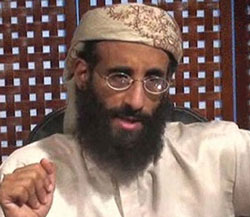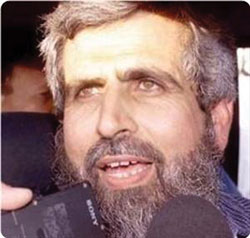Uneasy Targets: How Justifying the Killing of Terrorists Has Become a Major Policy Debate

Anwar al-Awlaki
With his American birth, loyalty to Yemen and dedication to radical Islam, Anwar al-Awlaki’s life was a raft of conflicts. So, too, was his death. Two Hellfire missiles shot from U.S. Predator drones struck the 40-year-old and his entourage last September as they traveled through the Arabian nation’s northern region.
Al-Awlaki was born of Yemeni parents in New Mexico in 1971. He went to Colorado State University, studying to be an engineer, and later received a master’s degree from San Diego State University.
But in 2010 President Barack Obama reportedly signed off on his targeted killing. Obama later praised the attack. Al-Awlaki “took the lead in planning and directing efforts to murder innocent Americans,” Obama said. “He repeatedly called on individuals in the United States and around the globe to kill innocent men, women and children to advance a murderous agenda.”
Al-Awlaki was drawn to Islamic fundamentalism in college when he traveled to Afghanistan after the Soviet occupation. By 2002 he left the U.S. altogether, eventually settling in his ancestral Yemeni village.
With his English fluency, al-Awlaki used the Internet to broadcast his lectures and sermons condemning the U.S. and inspiring other English-speaking extremists to join terrorism plots. The FBI identified him as a senior recruiter for the terrorist group al-Qaida.
Among his contacts was U.S. Army officer Nidal Malik Hasan, charged with killing 13 people and wounding 29 others in the November 2009 Fort Hood shootings near Killeen, Texas. Al-Awlaki praised Hasan: “The heroic act of brother Nidal also shows the dilemma of the Muslim-American community.”
Another contact was Umar Farouk Abdul mutallab, the suspect in the attempted bombing of a Detroit-bound Northwest Airlines jet on Christmas Day in 2009.
In 2010, al-Awlaki’s father filed a lawsuit in the U.S. District Court for the District of Columbia, claiming, among other complaints, that the U.S. government’s threats against his son violated his constitutional rights. But the court dismissed the case, denying jurisdiction, in December 2010.

Read all the articles in the Patriot Debate series:
WAR POWERS
- • Constitutional Dilemma: The Power to Declare War Is Deeply Rooted in American History by Richard Brust
- • War Powers Belong to the President by John Yoo
- • Only Congress Can Declare War by Louis Fisher
TARGETED KILLINGS
- • Uneasy Targets: How Justifying the Killing of Terrorists Has Become a Major Policy Debate by Richard Brust
- • Targeted Killing Is Lawful If Conducted in Accordance with the Rule of Law by Amos N. Guiora and Monica Hakimi
CYBERWARFARE
- • Cyberattacks: Computer Warfare Looms as Next Big Conflict in International Law by Richard Brust
- • What Is the Role of Lawyers in Cyberwarfare? by Stewart A. Baker and Charles J. Dunlap Jr.
COERCED INTERROGATIONS
- • Probing Questions: Experts Debate the Need to Create Exceptions to Rules on Coerced Confessions by Richard Brust
- • Should We Create Exceptions to Rules Regarding Coerced Interrogation of Terrorism Suspects? by Norman Abrams and Christopher Slobogin
DOMESTIC TERRORISM
- • Insider Threats: Experts Try to Balance the Constitution with Law Enforcement to Find Terrorists by Richard Brust
- • The Threat from Within: What Is the Scope of Homegrown Terrorism? by Gordon Lederman and Kate Martin
THIRD-PARTY DOCTRINE
- • Crashing the Third Party: Experts Weigh How Far the Government Can Go in Reading Your Email by Richard Brust
- • The Data Question: Should the Third-Party Records Doctrine Be Revisited? by Orin Kerr and Greg Nojeim
NATIONAL SECURITY LETTERS
- • Letters of the Law: National Security Letters Help the FBI Stamp Out Terrorism But Some Disapprove by Richard Brust
- • National Security Letters: Building Blocks for Investigations or Intrusive Tools? Michael German and Michelle Richardson, and Valerie Caproni and Steven Siegel
DETENTION POLICY
- • Detention Dilemma: As D.C. Circuit Considers Guantanamo Inmates, Can Judicial Review Harm Military? by Richard Brust
- • Detention Policies: What Role for Judicial Review? by Stephen I. Vladeck and Greg Jacob
U.S. intelligence spotted al-Awlaki Sept. 30 as he apparently stopped to eat breakfast with his colleagues. Also killed in the blast was Samir Khan, an American born in Saudi Arabia and editor of al-Qaida’s English-language online magazine, Inspire.
Two weeks later al-Awlaki’s 16-year-old son, Abdulrahman al-Awlaki, a U.S. citizen who was born in Denver, was also killed by a CIA-led drone strike in Yemen.
In hailing al-Awlaki’s death, Obama called the strike “a major blow to al-Qaida’s most active operational affiliate.” The killing, Obama said, “is further proof that al-Qaida and its affiliates will find no safe haven anywhere in the world.”
That last statement underlines one of the most crucial aspects of 21st century warfare: Can anyone—American citizen or not—become the object of a targeted killing anywhere in the world?
The question is key to the debate over the legal and moral justification of targeted killings by one nation against a nonstate aggressor, even when the prospective assailant seeks a separate nation’s protection.
That conflict forms the essence of the “new warfare,” says University of Utah law professor Amos N. Guiora. Where nations once marched uniformed armies against each other, those nations instead search for nonstate combatants who blend in and out of civilian life and slip from country to country.

Amos Guiora of the University of Utah.
Anticipating the worst consequences—ships destroyed, buildings bombed, innocent civilians attacked—nations seek out individual aggressors with deadly purpose.
Among the responses is the targeted killing, described in a 2010 United Nations report as the “intentional, premeditated and deliberate use of lethal force … against a specific individual who is not in the physical custody of the perpetrator.”
Guiora and University of Michigan law professor Monica Hakimi discuss the rationale behind targeted killings in Patriots Debate: Contemporary Issues in National Security Law, a book by the American Bar Association’s Standing Committee on Law and National Security. The committee invited both writers.
The book, expected to be published this spring, is the ABA committee’s second and offers broad concepts on issues of U.S. international law. The first, published in 2005, focused more exclusively on sections of the USA Patriot Act.
The experts agree on targeted killings’ legality: Both are in favor, provided capture and detention are unavailable. Nor do they differ on the slaying of al-Awlaki. “He went over to the other side,” says Guiora.
What separates Guiora and Hakimi are their methods for deciding when to undertake a targeted killing. While both acknowledge the extent and limits of established international law, which is governed by such institutions as the Geneva Conventions and the United Nations, each nevertheless evolves a set of rules that explains when targeted killings may take place in the “new warfare.”
Guiora, for example, allows for a system of “active self-defense,” determining who is a legitimate target and at what point during an aggressive act is it appropriate to undertake a killing.
Hakimi devises a more formal process. She extracts from international law three principles that weigh state security against pursuing a potential terrorist, and that allow government officials to decide when to engage in a targeted killing.
Yet to understand these two concepts requires an appreciation of how international law works, and why the new warfare is so different.

©Jack Kurtz/Zuma/Corbis
THE FINE POINTS OF INTERNATIONAL LAW
International law has two major regimes. One is international humanitarian law, also known as the law of armed conflict, which is primarily governed by the Law of the Hague and by the Geneva Conventions of 1949, as well as subsequent treaties. Its rules were first organized in the 19th century, when states became embittered by the tactics of modern warfare.
IHL regulates the conduct of armed conflicts, called jus in bello. It protects those not involved in warfare, mostly civilians, and those who are no longer participating. Note, too, that jus in bello, which deals with acts of war, differs from jus ad bellum, which involves criteria to be consulted before engaging in war to determine whether war is permissible.
International humanitarian law insists that captured combatants be treated humanely, and it prohibits torture, corporal punishment or degrading treatment. Violators may be charged with war crimes and brought before an international court.
Among IHL’s regulations is one crucial rule that weighs in on targeted killing: Article 51(3) of the Geneva Conventions’ 1977 Additional Protocol I protects civilians “unless and for such time as they shall take a direct part in hostilities.”
IHL differs from another set of rules, human rights law, which oversees hostilities between a state and its citizens and applies mostly in peacetime. Among the organizations that govern HRL is the United Nations.
Both international law regimes are examples of nations communicating with each other to oversee what might otherwise become more horrifying acts. Assembling treaties and regulations is what Hakimi in her essay calls the discursive process of rule-making.
A BLURRED NEW WORLD OF WARFARE
But with terrorist bombings in the late 1990s, followed by the explosive Sept. 11, 2001, attacks, and the Iraq and Afghanistan wars, the traditional laws of warfare have become more difficult to apply. Gone are the days of Napoleonic battalions, where two states sent uniformed forces against each other to fight on “hot” battlefields.
“In traditional conflicts between states, which pit soldier against soldier, the categories were clear,” writes Guiora in a 2010 Harvard National Security Journal article, “Teaching an Old Dog New Tricks: Operationalizing the Law of Armed Conflict in New Warfare,” which he co-authored with Emory University law professor Laurie Blank.
But with the new warfare, the writers add, “the categories are, at best, blurred. Simply put: The clear-cut traditional military paradigm is largely a relic of the past.”
Guiora’s active self-defense strategy offers a practical field-command approach to identifying and deciding whether to indulge in a targeted killing.
It operates on several principles. One is distinction—the ability of soldiers to differentiate between people they can target and people they are obligated to protect.
Another is proportionality, requiring soldiers not to attack “if the expected innocent casualties are excessive in relation to the anticipated military advantage gained,” he writes in the law review article.
Here he faults the Obama administration for too readily accepting collateral damage, injuries or death to civilians who may have accidentally come into range.
“It’s like Casablanca,” says Guiora in a telephone interview, “where they say, ‘Round up the usual suspects.’ That approach gives you cover, but it’s deeply disturbing and distressing. It’s so broad that it may be illegal or unconscionable.”
Deciding who is an unlawful combatant and when that person becomes one demands “pin-pointing”—accurate intelligence that determines when the aggressor has indulged in hostile action. It’s also crucial to determine imminence, whether the threat is so closely impending that it requires an immediate action.
Guiora stresses that the combatant is rarely a single individual. A “successful suicide bombing,” he writes in a 2004 law review article, “Targeted Killing as Active Self-Defense,” “is the working of a well-orchestrated, difficult to penetrate, highly disciplined, financially solvent terror organization, and not the act of a lone individual.”
It requires a doer, who carries out the mission; a sender, who oversees the operation; a logistician, who plans it; and a financier. “All four actors,” Guiora writes in his Patriots Debate essay, “are essential, individually and collectively.”
Guiora’s pragmatic approach to self-defense befits his military background. The son of two Holocaust survivors, he served in Israel’s Judge Advocate General’s Corps from 1986 to 2004, retiring as a lieutenant colonel.
Among his posts Guiora was legal adviser to the Gaza Strip military commander. There, he says, he learned on the spot the many levels of intelligence interpretation leading from the field command to his office—or to a phone call at 3 in the morning. From that often chaotic information he must decide whether an aggressor is an imminent threat, how many others are nearby, and whether to try to detain the person or to go ahead with a targeted killing. “It’s an awesome responsibility,” he says.
In his Patriots Debate essay, Guiora acknowledges Israel’s own strategy in dealing with terrorists, citing a key 2006 ruling by the Israeli Supreme Court, Public Committee Against Torture in Israel v. Government of Israel.
The petitioners argued that the conflict should be handled within the realms of policing and law enforcement, and that individuals should not be arrested or killed without due process. It “does not fit the definition of an international conflict,” the plaintiffs said.

Salah Shehada
Israel’s response was that this was an armed conflict, and that “the laws of war apply not only to war in the classic sense, but also to other armed conflicts.” It was a debate over whether to judge the Palestinians under the rules of human rights law or international humanitarian law.
The court, however, agreed to consider terrorists civilians who sacrifice that status under Article 51(3). The court elaborated on the definition of hostilities and when aggressive action occurs. It also sought to avoid the revolving door of civilians slipping into terrorist action, then diving back into the community for protection.
Guiora also recognizes how a targeted killing can lose proportionality. The Israeli air force bombed the Gaza City dwelling of Hamas leader Salah Shehada in July 2002, killing him and 14 others, including nine children and Shehada’s wife.
In February 2011, the Israeli Special Investigatory Commission concluded that Shehada was a “legitimate targeted killing.” Shehada was “aware of his fugitive status and frequently changed residences,” his danger to Israel was “certain, immediate and significant,” and his terrorist activity “categorized him as a civilian taking a direct part in hostilities at that time.”
But, the commission said, the slaying of civilians—the extensive collateral damage—made it a disproportionate attack.
“The whole question of what is the most legitimate target is so simple to ask and so complicated to answer,” says Guiora. “What is the appropriate international law regime? Should any of us know what the answer is?”

Monica Hakimi from the University of Michigan
PRINCIPLES FOR APPROPRIATE ACTION
University of Michigan professor Hakimi fashions a response by constructing a set of principles with which decision-makers can decide whether a detention or killing is appropriate.
The “liberty-security principle” weighs the security of the state’s interests against detaining or taking the life of a prospective aggressor; the principle of “mitigation” compels states to control and contain troublesome individuals; and “mistake” requires states to make sure the appropriate person is being prosecuted, detained or killed, depending on the severity of the threat.
Government officials may discuss and decide on whether to adopt the principles by using the discursive, rule-making process they have used for years to set up guidelines for international law.
“It makes more sense because of the discursive process,” Hakimi says in an interview. “This is the best method for trying to resolve subsequent questions and for holding actors accountable.”
A former attorney-adviser in the Office of the Legal Adviser at the U.S. State Department, Hakimi counseled on nonproliferation, the reconstruction of Iraq, international investment disputes and civil aviation. She also served as counsel before the Iran-United States Claims Tribunal and worked on cases before the International Court of Justice, U.S. federal courts and administrative agencies.
Hakimi criticizes Guiora’s active self-defense process as too unattached to a set of guidelines, terming it a hybrid—a free-floating process that can apply to any situation.
The result is uncertainty, Hakimi says. “Many modern situations do not fit comfortably in any domain, leading to intractable disputes about which one governs,” she says in her cited article, “A Functional Approach to Targeting and Detention,” to be published this year in the Michigan Law Review.
Public Committee Against Torture in Israel v. Government of Israel is a case in point of how the two regimes can clash. The plaintiffs insist that law enforcement based on human rights law should rule over an occupied territory; the Israeli government insists that terrorists have proven themselves enemies of the state, so the international law of armed conflict should apply. The court, meanwhile, devises its own ruling.
The al-Awlaki incident is another. “We are at war with al-Qaida,” said John O. Brennan, assistant to the president for Homeland Security and Counterterrorism, in a September address at Harvard Law School.
But that puts the U.S. in a bind, says Hakimi, who cites Brennan’s speech in her essay. The U.S. says it’s a global conflict, governed by IHL, “even though it does not intend to target al-Qaida members worldwide,” because applying human rights law where al-Qaida is inactive is “too limiting.”
“Just as the wartime paradigm is ineffective in legitimizing U.S. operations,” Hakimi says in her essay, “the law enforcement paradigm is ineffective in constraining those operations.”
Instead, she urges, break away from the regime dichotomy and establish the principles “that animate all existing law.”
“The categories don’t work,” she says. “Is al-Awlaki part of an armed conflict? Or is this person a civilian?
“That’s the conversation we should be having.”
Sidebar

2 Suits Seek DOJ Memo
The U.S. Justice Department is facing two lawsuits demanding that it reveal its justifications for last year’s targeted killings of three Americans in Yemen.
The American Civil Liberties Union filed the most recent suit Feb. 1. It seeks the department’s legal memos on the program, the government’s evidentiary basis for the strikes, and information about how the administration assembles its secret “kill lists.”
The New York Times filed a similar suit Dec. 20. Both are filed in the U.S. District Court for the Southern District of New York and seek records under the federal Freedom of Information Act. The government has turned down both organizations’ FOIA requests.
Both suits deal with “the power of the U.S. government to kill U.S. citizens without presentation of evidence and without disclosing legal standards that guide decision-makers,” according to the ACLU complaint.
Al-Qaida activists Anwar al-Awlaki, who was 40, and Samir Khan, 26, editor of al-Qaida’s English-language Web magazine—both American citizens—were killed by U.S. Predator drone missiles. Two weeks later al-Awlaki’s 16-year-old son, Abdulrahman al-Awlaki, who was born in Denver, was also killed by a drone missile strike.
On Sept. 30, the day al-Awlaki and Khan were killed, the Washington Post reported that the government had a secret memorandum authorizing the legal targeting, the ACLU said.
In an Oct. 8 story, the Times detailed information about the memo. According to the story, by reporter Charlie Savage, the memo was drafted in June 2010 by David Barron, now a Harvard law professor, and Martin Lederman, a law professor at Georgetown, when they served in the Office of Legal Counsel.
The document justified the targeted killings “despite an executive order banning assassinations, a federal law against murder, protections in the Bill of Rights and … of the international laws of war,” Savage wrote. The story also said that Yemeni authorities were unable or unwilling to stop al-Awlaki.
The memo concluded that it would not be a war crime if a nonuniformed official such as a Central Intelligence Agency officer, rather than a uniformed officer, fired the drone missile, according to the story.



